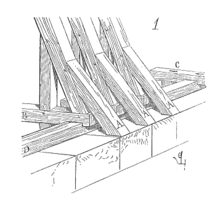
Back رافدة Arabic Spars BAT-SMG Кроквы Byelorussian Krokev Czech Папка (архитектура) CV Spær Danish Sparren German Ĉevrono Esperanto Par (arquitectura) Spanish Sarikas Estonian




A rafter is one of a series of sloped structural members such as steel beams that extend from the ridge or hip to the wall plate, downslope perimeter or eave, and that are designed to support the roof shingles, roof deck, roof covering and its associated loads.[2] A pair of rafters is called a couple. In home construction, rafters are normally made of wood. Exposed rafters are a feature of some traditional roof styles.
- ^ Mayda, Chris. Regional geography of the United States and Canada: toward a sustainable future. Lanham, Md.: Rowman & Littlefield Publishers, 2013. 264. ISBN 0742557308
- ^ "rafter (1)". encarta.msn.com. Microsoft. Archived from the original on January 25, 2007. Retrieved July 4, 2017.